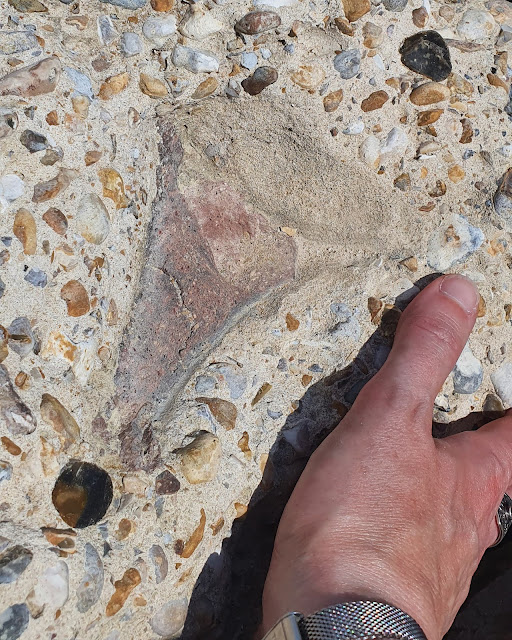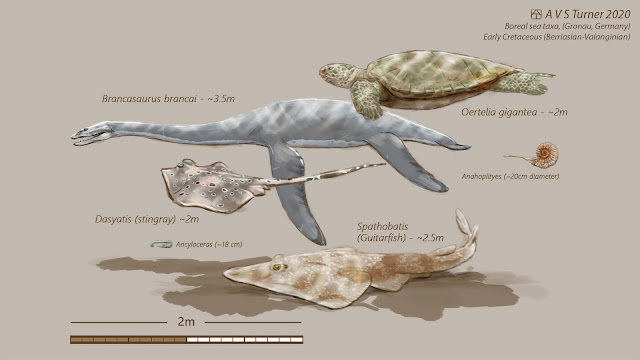Dino-tours: Berlin Part I - Giraffatitan
| Me with Giraffatitam brancai |
Well, last week I finally did it! OK, so it only took me about 28 years, but I got there, people! Mike had been once before a few years ago, but fortunately, being a bona fide sauropod nerd he was more than happy to tag along for another crack at the Naturkunde museum. So, this was to be not only the realisation of a childhood dream for me, but also my first ever Dino-tourism excursion with an accomplice!
So, enough pre-amble: let's talk dinosaurs. In our eagerness we managed to arrive at the Museum für Naturkunde about an hour before opening time, so we were ready and waiting when the doors first opened to run in (litrally like a pair of excited kids) before anyone else. Having spent a lifetime waiting to see the Giraffatitan (the species was reclassified in 1991, but the name took some time to infiltrate English school books), I wasn't sure how I'd react to finally seeing it. Would I cry? Would I faint? Would I be able to feel anything at all? But a word to intrepid dino-tourists: the museum layout leaves no time or space for contemplation. You enter through the main doors and the enormous legs and thorax of the Giraffatitan are smack-bang in front of you!
I'd have to say that even if you're not a dinosaur geek, the Giraffatitan specimen is something you really must go and see. The sheer scale of the animal is beyond arresting. The term 'Titan' doesn't make sense until you've stood in the same space as something that can dwarf you on the scale that Giraffatitan does. Of course, I've felt similar tingles stood in the Natural history museums in London and New York, when surrounded by whale skeletons and models, but those are aquatic species. The tingles are of a completely different nature when you realise that this thing moved through the air, on land as you do, defying all the same laws of gravity and atmospheric pressure as your tiny bag of organs does. Words really don't describe it.
And it seems photos don't do a much better job of describing it either; the specimen being so huge as to defy our cameras' abilities to capture the entirety of the specimen from any angle! We did observe at the time that it would be super-sweet if they were either to erect a mezzanine level around the dinosaur hall to view the "march of the sauropods" from closer to the titan's head; or else open up some of the rooms on the first and second floors (currently these seem to be used for storage, which is a shame because they would make amazing observation spots for the dinosaurs in the atrium), but for now visitors must make do with feeling dwarfed from below.
Mike was particularly keen to see if the museum had updated their signage on the Giraffatitan, which had still been labelled as 'Brachiosaurus brancai' upon his last visit some years back. Alas, he was disappointed to find that the museum has seemingly "not got around to this yet". We surmised that this is probably largely a marketing issue: many audiences will be familiar with 'Brachiosaurus', as it features in the opening sequence of 'Jurassic Park'. However, 'Giraffatitan', whilst no less spectacular, has less celebrity status and so is perhaps less likely to draw the crowds?
Mike was particularly keen to see if the museum had updated their signage on the Giraffatitan, which had still been labelled as 'Brachiosaurus brancai' upon his last visit some years back. Alas, he was disappointed to find that the museum has seemingly "not got around to this yet". We surmised that this is probably largely a marketing issue: many audiences will be familiar with 'Brachiosaurus', as it features in the opening sequence of 'Jurassic Park'. However, 'Giraffatitan', whilst no less spectacular, has less celebrity status and so is perhaps less likely to draw the crowds?
| Stygimoloch spinifer |
The intimacy of our encounter with Archaeopteryx and high emotion for me of seeing the Giraffatitan for the very first time were not spoiled by heaving crowds. Despite the relatively small scale of the atrium (given its residents!), it was not unpleasantly busy as we had expected it to be on a Saturday, so we were at our leisure to cruise around; gawping, snapping and sketching.
Speaking of which; I did a classic turn and actually forgot to pack my sketchbook! So one of our first stops was actually to run into the museum shop and grab a notebook, pen and a couple of obligatory T-shirts. As usual, my gripe is that the coolest T-shirt designs are available in men's and kids' sizes, but not in women's (#everydayDinoSexism anyone?). Still, the shop is still by far one of the finest I've ever visited and much of their merch is available online at naturkundemuseum-shop.de
That's just about it for this post, but this wasn't the end of our adventure in the Museum für Naturkunde: there were plenty more surprises in store for us, so please join me for Part II, where we'll be meeting a celebrity guest...
Here are a few logistical tips for anyone wishing to visit the Museum fur Naturkunde:
1. Travel: The Naturkundemuseum stop is on the U6 (purple) line on the U-bahn. Berlin's public transport is easily navigable and there's no awkward barriers to go through: just grab your ticket (machines offer translations in several languages), remember to validate it in the little yellow stamping machine on the platform and you're free to travel! Upon reaching the station, you can either take an underpass that leads you to the museum (a lovely lady Allosaurus fragillis will show you the way!), or else head topside as we did for a short walk in the open air.
We used lastminute.com to arrange flights from the UK. Tegel airport is very close to the city centre and a short ride by the TXL bus will take you to the nearest U-bahn .
We used lastminute.com to arrange flights from the UK. Tegel airport is very close to the city centre and a short ride by the TXL bus will take you to the nearest U-bahn .
2. Accomodation: We stayed in Prenzlauer Berg, which is a very trendy, bohemian part of town. We found this to be an ideal place to pitch basecamp because it's filled with lovely cafes and restaurants, which cater both for those on a budget (like us!) and also offer more high-end choices for if you want to really push the boat out. Also Prenzlauer Berg has a relaxed, artsy culture, which makes it a great place to decompress after a day of adventures.
We used booking.com to arrange accommodation; please use the search box below if you're planning on booking your own Dino-adventure!
We used booking.com to arrange accommodation; please use the search box below if you're planning on booking your own Dino-adventure!

